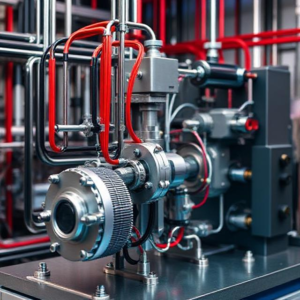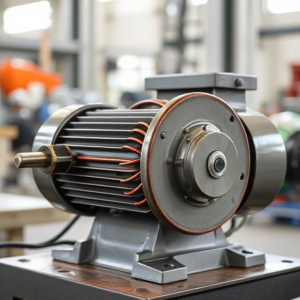1. What is an Electromechanical System?
An electromechanical system is a system that combines electrical and mechanical components to perform a specific task. In simpler terms, it uses electricity to create motion or other mechanical effects.
These systems convert electrical energy into mechanical energy (or vice versa) to perform a wide range of functions.

2. How Do Electromechanical Systems Work?
Electromechanical systems work by using electric current to control mechanical parts. Here’s how the process works:
- Electrical Energy Input: The system gets electricity as input (from a battery or power source).
- Conversion to Mechanical Energy: Electrical components (like motors or actuators) convert the electrical energy into mechanical motion (like rotating, moving, or lifting something).
- Mechanical Output: This motion can then be used to perform a physical task, such as opening a door, moving a robot, or turning a wheel.
3. Key Components of Electromechanical Systems
There are a few important parts that make up electromechanical systems:
a. Electric Motors
- Motors are the heart of most electromechanical systems. They take electrical energy and convert it into mechanical motion.
- There are different types of motors, like DC motors and AC motors, depending on the type of current they use.
b. Sensors
- Sensors are used to detect changes in the system and provide feedback. For example, a temperature sensor might control a fan, turning it on or off depending on the room temperature.
- Sensors help the system to respond to the environment and perform tasks more accurately.
c. Actuators
- Actuators are devices that move or control a mechanism. They convert electrical signals into physical movement, like opening a valve, moving a robotic arm, or lifting an elevator.
d. Control Systems
- These are the brains behind electromechanical systems. A control system uses information from sensors and decides how to activate motors and actuators to make the system do what it’s supposed to.
- It can be something simple like a thermostat controlling a fan, or something complex like a robot’s central computer coordinating its movements.
4. Examples of Electromechanical Systems
Here are some real-life examples of electromechanical systems that we use every day:
a. Electric Fans
- An electric fan has an electric motor (the electrical part), which spins the blades (the mechanical part) to create airflow.
b. Electric Cars
- Electric cars use electric motors to move the wheels. The car’s battery provides electrical energy, and the motor converts that energy into motion to make the car move.
c. Robotic Arms
- A robotic arm has motors (electrical part) that control the arm’s movement (mechanical part), allowing it to perform tasks like lifting, assembling, or packaging items.
d. Elevators
- An elevator uses an electric motor to move the elevator platform up and down in a building. It uses sensors and control systems to stop at the right floors.
e. Washing Machines
- In washing machines, an electric motor is used to spin the drum, which moves the clothes. The system also includes sensors to detect water levels and adjust the washing cycle.
5. Applications of Electromechanical Systems
Electromechanical systems are used in many industries and applications, including:
- Manufacturing: Machines on assembly lines use motors and sensors to perform tasks like welding, cutting, and assembling products.
- Medical Devices: Equipment like MRI machines and prosthetics rely on electromechanical systems for movement and precision.
- Automation: Robots in factories use electromechanical systems to perform tasks like picking up objects or packaging products.
- Home Appliances: Appliances like refrigerators, dishwashers, and vacuum cleaners use motors and sensors to perform their tasks efficiently.
- Transportation: Electric trains and elevators are examples where electromechanical systems are used to move people or goods.
6. Types of Electromechanical Systems
There are different types of electromechanical systems, depending on the task they need to perform:
a. Actuation Systems
- These systems are used to move or control an object. For example, a robotic arm that picks up parts or a car’s electric window that moves up and down.
b. Control Systems
- These systems monitor and regulate the performance of machines or processes. For example, an automatic thermostat that controls the heating or cooling in a house.
c. Sensors and Feedback Systems
- These systems use sensors to gather information about the system’s environment or status and provide feedback. For example, an anti-lock braking system (ABS) in cars uses sensors to monitor wheel speed and adjust braking pressure to prevent skidding.
7. Benefits of Electromechanical Systems
Electromechanical systems offer many advantages, including:
- Efficiency: They can automate processes and perform tasks quickly and accurately.
- Precision: Control systems and sensors ensure the task is performed with great precision.
- Versatility: Electromechanical systems can be designed for a wide range of applications, from household appliances to industrial robots.
- Energy Savings: Well-designed electromechanical systems can use energy more efficiently, such as energy-efficient motors in electric vehicles or appliances.
8. Challenges in Electromechanical Systems
Despite the many advantages, electromechanical systems face some challenges:
- Complexity: These systems can be complex to design, as they involve both electrical and mechanical components that need to work seamlessly together.
- Cost: Some electromechanical systems, especially in advanced applications like robotics, can be expensive to develop and maintain.
- Maintenance: The mechanical components (like motors or gears) may wear out over time and need maintenance or replacement.
9. Future of Electromechanical Systems
As technology continues to advance, electromechanical systems are becoming more sophisticated and widespread. Some future trends include:
- Smarter automation: Electromechanical systems will become more intelligent, using advanced control systems, sensors, and artificial intelligence (AI) to perform more complex tasks.
- Miniaturization: Components like motors and sensors will continue to get smaller and more efficient, enabling portable electromechanical devices, like wearables or drones.
- Green technology: There is a growing focus on designing electromechanical systems that are energy-efficient and environmentally friendly, like electric vehicles and renewable energy systems.
Conclusion
An electromechanical system is any system that uses both electricity and mechanical parts to perform a function. These systems are everywhere around us, from the motors in fans and washing machines to the robots in factories. They play an essential role in making our devices efficient, precise, and automated.











